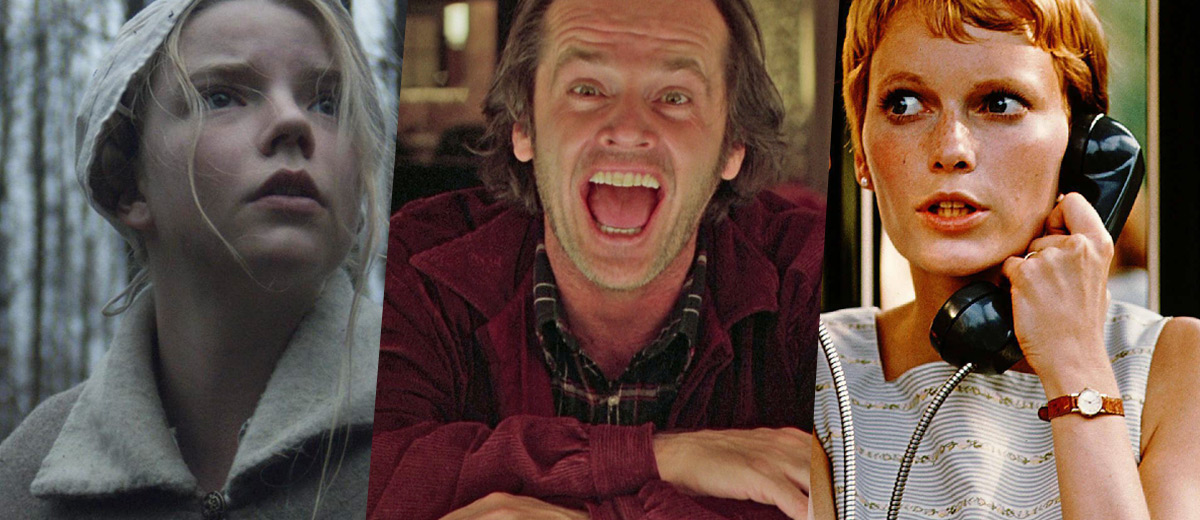 Sissy Spacek in “Carrie” (1976)
Sissy Spacek in “Carrie” (1976)
Three years after making her first big feature appearance in “Badlands,” Sissy Spacek turned her delicate demeanor into the facade of a frightening power as the eponymous Carrie. Brian de Palma directed the hell out of the first Stephen King screen adaptation, and, with some help from composer Pino Donaggio and DP Mario Tosi, put that hell into Spacek, whose protuberant look during the pandemonium on prom night is one of the genre’s most iconic frames. All sensitivity and softness at first, Carrie’s cries of help during the harrowing opening pierce your soul, and then her insane mother’s torments (Piper Laurie’s towering portrayal narrowly missed our list) continue to twist that knife. Spacek’s incandescence pulls us in with boundless sympathy, which make her telekinetic glances of horror (a little too obviously referenced by the screeching sounds of “Psycho”) all the more potent as we recoil and squirm in dread. It was the first of her five Oscar nominations, and surely one of the most heartrending portraits of victim-turned-villain in the history of the genre.
 Naomi Watts in “Mulholland Drive” (2001)
Naomi Watts in “Mulholland Drive” (2001)
After a string of bit parts and supporting roles without anyone knowing her name, Naomi Watts made her big breakthrough on the film scene with a sensually capricious and emotional performance in David Lynch’s masterpiece “Mulholland Drive” Gullible and naive at first, her Betty evolves throughout the film’s reveries and contorted structure into a hardened femme fatale, and Watts carries the film’s mysteries and warped layers in scintillating fashion. Next to the excellent Laura Harring, who portrays the film’s mysterious Rita, Watts had the material and the inspiration to showcase just how wide her range is, and after it was over — the sky was the limit. It’s nearly impossible to single out a standout moment (Silencio? The look she gives Justin Theroux when they first meet? So many…) but the sequence that stands out as eerily parallel to the rapid rise of her own stardom is the audition scene, where all of Betty’s super-charged dark perversity bubble up to the surface for the first time. In other words, this is the girl.

Sigourney Weaver in “Alien” (1976)
Ridley Scott may have trailed on the beaten path in recent times, but his decision to slap convention in the face and turn the originally-planned male hero of “Alien” into the badass heroine Ellen Ripley was fabulously progressive for the 70s, and will forever be a shining star in in the cosmos of the horror genre. Of course, none of it would have been half as iconic were it not for Sigourney Weaver’s controlled, mature and effective portrayal in the first film (followed by an arguably better performance in the more action-oriented sequel “Aliens”). She plays the part of Nostromo’s warrant officer with incredible conviction, all the more impressive since this was Weaver’s first big role. Thanks in large part to Weaver’s performance, some of the film’s scenes — like the fear-inducing final moments — have been immortalized as prototype examples of sci-fi terror. Neill Blomkamp’s highly anticipated continuation of the series will see Weaver return to her greatest role, but we’ll have to wait until Scott’s “Alien: Covenant” is done first. The Guardian’s Ben Child writes what everyone’s thinking: “If the saga has any hope of getting back to its own 70s and 80s high point, it surely needs to bring the original all-action Hollywood scream queen along for the ride.”
 Anthony Perkins in “Psycho” (1960)
Anthony Perkins in “Psycho” (1960)
The casting of Perkins in the role of Norman Bates is up there among the most genius of Hitchcock’s moves. Affable, pleasant and honey-tongued, Perkins’ demeanor was the picture of pacifism in the late 50s. Mostly because of his Oscar-nominated breakthrough role in William Wyler’s “Friendly Persuasion” in ‘56. But once Hitchcock persuaded him to portray Bates, his real breakthrough came — not only overshadowing every role he played before, but every role to come thereafter. Perkins, and his malevolent smile, went on to reprise the role in three subpar sequels but none of them hold a candle to the quietly sociopathic and demented mother’s boy we first met in “Psycho.” With an awkward presence that’ll make you think he couldn’t hurt a fly, Perkins redefined the soft facade of psychopaths for all generations to come.
 Linda Blair in “The Exorcist” (1973)
Linda Blair in “The Exorcist” (1973)
Arguably the most difficult role on this list, and certainly the most challenging considering that it had to be performed by a 12-year-old girl, the character of Regan MacNeil is as pivotal to the story of “The Exorcist” as the actor’s performance of Regan was to the success of the film. Considering the film’s gigantic success, it’s safe to say Linda Blair’s portrayal is one for the ages. The vigor and authenticity she brought to the role of the demonically possessed Regan manages to simultaneously break hearts and send icy chills down our spines to this day. Her transformation from a sweet and vivacious girl to Satan’s pawn who masturabtes with crucifexes and torments her poor mother is all the more chilling for being so goddamn believable. The entire ensemble, which included Ellen Burstyn, Jason Parks and Max Von Sydow, was a match made in heaven, but none of the adults can really come close to the fear-inducing mark left by Blair.






Rosemary’s Baby was released in 1968, not 1960.
who gives a fu k
it was directed by a pedo and it got sharon tate killed
That is actually not from Frankenstein, that is Son of Frankenstein. Basil Rathbone and Bela Lugosi are the other actors.
http://compagnie-avril.com/wordpress/wp-content/uploads/2015/11/visuel_frankenstein.jpg
Belen Rueda in “The Orphanage” is one I’d like to watch again
To me neither Mulholland Dr nor Black Swan are really horror films, but I’ll go with it…
who the fuck’s Jason Parks? it was Jason Miller. get it right.